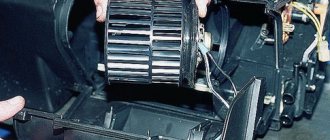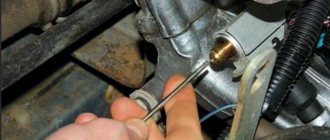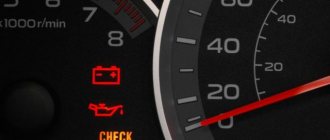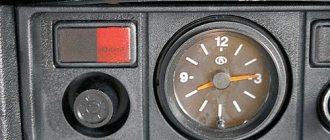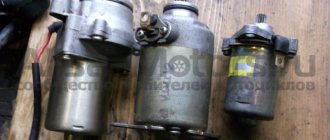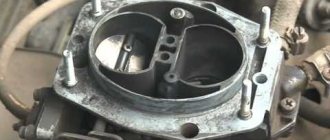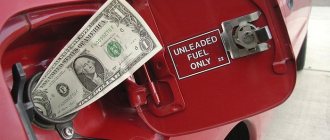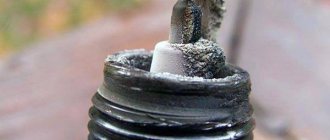Many motorists, residents of regions with harsh climates, know how difficult it is for a car engine to start in cold weather. Most often, this situation occurs during sudden changes in temperature, when in the evening you see -10ºС on the thermometer, and in the morning it is already -30ºС. The problem also arises in cases where the car is left in the cold for several days in a cold garage or on the street.
Why does the engine refuse to start in cold weather?
Most of the inhabitants of our country live in regions with harsh climates and even extreme winter conditions. This period of time turns into a serious test for all citizens without exception, including motorists, for the majority of whom failure to start the engine in cold weather becomes a real headache. Moreover, the most unpleasant thing is that even owners of new cars are not insured against this. What are the reasons for such failure and how can this be dealt with? Dear readers, today our online publication offers you detailed instructions on this issue, which you can personally read.
As you know, cold weather (especially severe frost) has a serious negative impact on any car. A vehicle is a complex technical device that requires the coordinated operation of many of its systems to run.
And sometimes it can be very difficult to figure out which of these systems led to the failure to start the engine, but nevertheless, friends, it is possible.
See also: 27 questions from motorists about the cold
So, what components of the car are primarily affected by frost? The most common causes of engine failure are the following problems: - with the battery, with the fuel system, with the starter, with the generator and with the engine oil. Let's look at each problem in more detail and separately.
Electrical fault
Most of the vehicle electrical equipment failures occur in winter. Main reasons:
- electrolysis processes;
- increased currents in power supply circuits;
- increased corrosion at high humidity.
Electrolysis inflicts the greatest blow on a car's electrical wiring in winter. How it happens. As a result of strong temperature changes in the engine compartment, the polyvinyl chloride insulation of the conductors begins to crack. Salty moisture penetrates into microcracks (the result of road treatment). Between the car body, connected to the negative bus of the battery, and the positive potentials of the current-carrying conductors, which are exposed to the salty electrolyte, the process of electrolysis begins to operate.
Positive copper ions rush towards the negative body in a friendly stream. As a result of this, the fatal destruction of the conductor occurs: it turns into green dust. First, this leads to malfunctions in the operation of electrical equipment, then to the complete failure of individual components and engine shutdown. Preventive measures: timely removal of contaminants;
- application of special protective coatings;
- engine protection.
Non-conductive silicone grease in spray form works well as a protective coating. It can be applied to conductors, contacts, harnesses.
The most dangerous from the point of view of failure to start the engine is corrosion at the point where the negative bus from the battery is connected to the car body and to the engine. Before the start of the season, you should definitely check the quality of these compounds.
In gasoline engines, it is necessary to evaluate the integrity of high-voltage wires and the absence of breakdowns. This can be done visually, attempting to start it in the dark. A spark will be observed at the breakdown site. The faulty wire must be replaced, preferably as a whole set.
Battery problem
If your car does not start in cold weather, then, of course, the most likely reason for this lies in the battery (in 80% of cases, failure to start the engine in cold weather is associated with the battery). Moreover, what is most interesting is that even the owner of a new car can encounter a similar problem. The point here is the following, namely, even in a new car, the battery can, as you all know, simply discharge, as a result of which the battery does not have enough energy to crank the starter to start the power unit.
Signs of a low battery: If, when turning the key in the ignition to start the engine, you suddenly hear howling sounds, but for some reason the starter does not turn, then most likely the battery charge in your car is low. Ultimately, the starter simply does not have enough energy to work properly.
Please note that if the battery is completely discharged or there are problems with the high-voltage wires, then when you start the engine you may not hear anything at all.
Also, if your car’s battery is completely and completely dead, then you are unlikely to see brightly lit symbols on the dashboard when you turn the key in the ignition switch.
In some cars, even the security system may stop working if the battery is completely discharged. In particular, if the battery is “dead,” the central lock itself may not work.
Solution: If your car won't start and you're pretty sure it's due to a dead battery, you have a few options:
— Start the engine using another vehicle (“light” from another vehicle).
— Instead of a discharged battery, install another charged battery.
— Remove the battery and take it home, and then put it on charge.
It is possible that the battery in your car has completely failed. For example, over time, old batteries simply no longer hold a charge. In general, everything turns out exactly the same as on smartphones, whose batteries also wear out over time and cannot hold the required charge for a long time. So in this case, you will have to spend money and buy a new battery. But how do you know when it's time to buy a new battery?
To do this, you need to charge the discharged battery and then check its performance in the car. If the battery quickly discharges again in the cold, then it’s easier to buy a new battery. This will be a better option than having to worry about restoring an old battery.
But unexpected discharge of a car battery is not always associated with its expiration date. For example, as we said above, the battery can run out in the cold even in a new car. How so. you ask? Very simple. Let’s say that if the car sits in severe frost for only a few days, the charge in the new battery can significantly decrease. As a result, when starting the engine, the energy stored in the battery may simply not be enough to start and start the engine.
Also, a completely serviceable and fresh battery can be discharged due to insufficient charge. This is especially true for those car owners who do not often use their cars in winter or drive them mainly for short distances. But the thing is that when the engine is cold started in the cold, too much energy from the battery itself is consumed, which is why everything happens like this. By the way, due to undercharging of the battery, its service life may also decrease. Therefore, we advise you, friends, if you rarely use your car or on frequent short trips, recharge the car battery from time to time either using a special charger, or once a week, travel by car for at least 40 or 50 minutes.
Naturally, after starting the engine, the battery replenishes lost energy from the generator, which in turn receives torque directly from the engine. But, to our great regret, the battery itself cannot quickly restore and replenish its charge. To do this, he needs from 5 to 40 minutes, depending on the make, model of the car and weather conditions.
It is clear that during short trips, your car’s battery (especially in winter) may not have time to recharge from the generator. As a result, this battery charge may gradually decrease over time. Now imagine that with such a low battery charge you will have to start your car, which has been standing in severe frost for about. a few days. It would be logical that your car simply won’t start.
How can you increase the life of a car battery?
In addition to regularly charging the battery in the winter, each motorist can increase the battery life by following a number of the following recommendations:
- Before turning off the engine at the end of a trip, turn off all electrical equipment in the vehicle, including the side and low beam lights, windshield wipers, heater and radio.
- Be careful not to allow corrosion to form on the battery clamps (terminals) or cables as this may interfere with the flow of electricity. With the engine off, clean any corrosion from the terminals with a wire brush or have the battery terminals cleaned by a garage.
- Before turning on the ignition, make sure that all electrical equipment in the car is turned off.
- Avoid heating seats, mirrors and windows for longer than necessary . All this requires a lot of energy. As a result of excessive energy consumption, the battery experiences greater load. Also try not to use the record player or radio while the car engine is off. Keep in mind that your car's audio equipment also consumes too much power, putting further strain on your car's battery.
- If possible, park your car in a warm garage , especially if it is expected to be very cold outside.
- Maintain the battery properly , especially when it has been in use for more than three years.
- When leaving the car, make sure that the side lights are turned off , and the low beam headlights are also turned off, and also make sure that you do not forget to unplug the gadgets connected to them from the cigarette lighter or USB connector.
Problems with the generator
An alternator is an electrical generator that charges a vehicle's battery while the engine is running. If your car has a relatively new battery, but for some reason it constantly loses charge (even in the absence of frost), then the generator itself may be the likely cause.
See also: Engine won’t start: How to find out the cause of the problem
Signs of a generator malfunction: The car engine started, but then stalled almost immediately; flickering car headlights; Dashboard flickering or dim icons on the dashboard; a burning smell in the cabin coming from overheated equipment.
Solution: If you do not understand the device and how to repair a car, then at the first sign of generator failure, contact a technical center.
Unfortunately for us and many motorists, buying a new generator is an expensive proposition. But a broken component (unit) in a car does not always require the purchase of a new one. It also happens that the old generator can be restored. And its repair itself will cost you less. It is noteworthy that a refurbished generator can last exactly the same amount of time as a new generator.
How to start a car in cold weather?
Surely, every car enthusiast in his life has once or twice been faced with the fact that his “four-wheeled friend” does not want to, or simply cannot, start in the cold. Taking into account that the weather in winter can be completely unpredictable from year to year, it is quite difficult to predict whether your car will fail in the morning. How can you protect yourself from such unforeseen circumstances? The answer is very simple, as doctors would say - prevention. The best thing to do would be to contact the service center of your official dealer boravto-vrn.ru - specialists will carry out all the necessary diagnostics and put the car in order.
Starter problems
Another common cause of engine failure is the failure of the starter, which uses electricity directly from the battery to operate. It is the starter that starts the engine of the car. By the way, many modern cars today are equipped with stop-start systems. As a rule, such cars have high-power starters with an extended service life, this is done so that it can cope with the constant cycle of turning the engine on/off when the car is stopped. However, sooner or later even the most reliable starters fail. Moreover, to the surprise of many motorists, the service life of such starters in cars with a stop-start system is on average slightly lower than in cars without such systems.
Signs of a faulty starter: The most obvious sign is clicking noises when turning the ignition key and failure to start the engine.
But how can you find out that the car does not want to start due to a discharged battery? Everything is very simple here. For example, if at the time of starting the engine the electrical equipment of the car is working normally (including the headlights themselves), then most likely the failure to start the engine is specifically related to the starter itself.
Solution: Naturally, if the starter malfunctions, it must be dismantled for further repairs, or for the subsequent installation of a new unit. By the way, usually workshops that overhaul starters offer clients not to wait for the repair to be completed, but offer to purchase from them an already restored mechanism (starter). In this case, you must return your starter and, after paying extra, pick up another starter that is already in working order. In some cases, you can save yourself a lot of time this way.
Unfortunately, not in all cases the car starter can be repaired. Everything naturally depends on the type of failure.
About DTOZH
In general, power unit temperature sensors are the most important regulators of an injection engine. There are two of them on it. One is located directly in the cylinder head, it displays the temperature value on the instrument panel.
The second one is located in the thermostat, and provides data on the temperature of the control unit of the power unit. Based on the results obtained, the control unit regulates the fuel supply - it supplies more fuel to a cold internal combustion engine, and less to a hot one. In addition, it is the control unit that regulates the OZ, influences the ignition of the fuel assembly, and activates the coolant fan if the liquid temperature rises above 100 °C.
Obviously, with faulty DTOZh there will be difficulties in the operation of the motor. However, this applies more to the DTOZH, which provides information directly to the block. For example, if the DTOZH is faulty, it will give false values about a cold engine, although it is already boiling. The supply of fuel to the cylinders will increase, because this is provided by the system. Let's say you drove for a long time, then stopped and went into a store. Now starting the power unit will cause obvious displeasure, since it will take a very long time to start due to data failures and oversaturation.
Why does the injector take a long time to start due to DTOZH
At the same time, the SOP, which is responsible for the ignition of a fuel assembly that is clearly over-enriched, changes greatly. As a result, the fuel will evaporate intensively, and the concentration of gasoline in the fuel assembly will be so high that the mixture will hardly ignite due to the small amount of oxygen.
It was said above that when you press the accelerator pedal, the startup time will be noticeably reduced. Now it becomes clear why this happens. By pressing the gas, we add oxygen to the fuel assembly, and the fuel ignites faster.
Thus, by replacing a faulty DTOZh, you can solve not only the problem with long-term starting of the internal combustion engine, but also other difficulties relating to the process of engine operation and its cooling system. The engine, after replacing the faulty DTOZH, will add stability, throttle response and power.
Problems with the car's fuel system
Over time, the vehicle's fuel system can become contaminated and cause the engine to fail to start due to insufficient fuel in the injection system. Water may also get into this fuel system (for example, as a result of condensation accumulating or low-quality fuel entering the fuel tank), which, naturally, will quickly turn into ice in severe frost. And this threatens problems with fuel ignition. As a result, under certain conditions you simply will not be able to start the engine in the cold. Remember, friends, that the fuel line in a car is not large enough in diameter and even small ice particles can completely stop (block) the circulation of fuel.
Signs of a fuel system malfunction: When starting the car, the engine almost started, but then misfired. The engine starts, but it runs somewhat unevenly (the speed jumps). The car lost power. While driving, the engine may sometimes stall.
Yes, it is undeniable that all these symptoms may also indicate other problems with the car (including problems with sensors), but if you still encounter the problem of starting the engine in the cold, you should first of all, together with the battery , generator and starter, check the functionality of the fuel system.
Solution: If water has entered your vehicle's fuel system, you may need to have the entire fuel line professionally flushed, which is done at an auto repair center.
You can also personally reduce the risk of water forming in the fuel system. To do this, you need to use special fuel additives, which are sold in many car dealerships. As a rule, such products contain alcohol, which can, by collecting and holding water, then remove it directly through the exhaust system of the car. In particular, we, for our part, advise you to fill a full tank of fuel in the winter season in order to reduce the risk of large amounts of condensation forming in the gas tank.
If your car runs on diesel fuel, then try to use only high-quality fuel in it. Always remember that otherwise low-quality diesel fuel can simply freeze in the cold, thereby preventing the engine from starting.
You are using the wrong engine oil
First of all, the engine oil itself is affected by frost. So, for example, the lower the temperature outside, the thicker the oil will become. This will make it difficult for the engine to operate, which in turn will place greater and additional stress on the battery itself. As a result, when the oil has literally frozen and turned into a jelly-like, heavy-flowing mass, starting the engine in the car can be difficult.
Signs of problems with starting the engine due to engine oil: If the engine oil in your car becomes too viscous at low temperatures, then most likely you will not be able to start the engine, since at the time of such a start the starter will not be able to crank it. To reliably start your car in winter, use winter motor oils that have a low viscosity for the engine. It is worth noting right away that it is better not to use such motor oils at high positive temperatures, since they will not provide high-quality engine lubrication.
Solution: Check your vehicle's owner's manual to find out for yourself what engine oil the manufacturer recommends. If there is such a tolerance according to the instructions, then switch to a more viscous engine oil for the winter period (fill the engine with winter oils), or use all-season grades of engine oils.
Here is a list of motor oil designations that are suitable for use in the winter season: SAE 0W, 5W, 10W, 15W, 20W, 25W.
Pay your attention to the number in front of the Latin letter W. The smaller it is, the lower the temperature threshold for using the oil. Accordingly, if you live in a region with cold climatic conditions, the most optimal engine oil may be with the designation 0W . True, it is necessary to remember here that this should be done only if the automaker allows the use of just such markings in the car manual.
